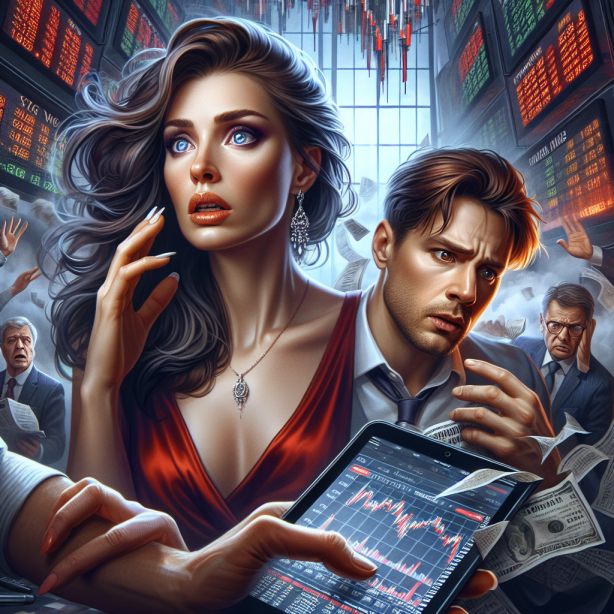
Contagion Theory: How Panic Ignites Chaos in the Stock Market
Sept 22, 2024
In the labyrinthine world of financial markets, where fortunes are made and lost in the blink of an eye, the phenomenon of panic spreading like wildfire is a testament to the fragility of human psychology. This essay delves into the intricate mechanisms of contagion theory, exploring how fear and uncertainty can transform rational investors into a herd of “spineless rats,” as H.L. Mencken might colourfully describe them. We shall unravel the complex tapestry of market panics and their far-reaching consequences by weaving together insights from mass psychology, technical analysis, and behavioural psychology.
The Anatomy of a Market Panic
To understand the spread of panic in the stock market, we must first dissect its anatomy with the precision of Sherlock Holmes. A market panic is a rapid, often irrational, collective response to perceived threats or uncertainties. It transcends mere economic factors, tapping into the primal fears and instincts that lurk beneath the veneer of human rationality.
As Oliver Cromwell once astutely observed, “He who stops being better stops being good.” In financial markets, this wisdom translates to the relentless pursuit of gains and the equally fervent avoidance of losses. When fear takes hold, this pursuit can quickly devolve into a heated race to the exits, with each participant desperately trying to outpace their fellow investors.
The Contagion Mechanism
Contagion theory posits that emotions and behaviours can spread through a population, much like a virus. In the stock market, this manifests as a rapid transmission of fear and panic from one investor to another, often facilitated by modern communication technologies and high-frequency trading algorithms.
Charlie Munger, the sage of value investing, offers a pertinent insight: “Show me the incentive, and I will show you the outcome.” In the case of market panics, the incentive is self-preservation, and the outcome is a cascading sell-off that can quickly spiral out of control.
Technical analysis provides us with tools to visualize this contagion. Chart patterns such as the “death cross” or rapidly declining moving averages can serve as visual representations of panic spreading through the market. While not infallible, these technical indicators often become self-fulfilling prophecies as traders react to them, further fueling the contagion.
The Psychology of the Herd
Behavioral psychology offers crucial insights into why individuals who may ordinarily behave rationally succumb to a herd mentality during market panics. The phenomenon of “loss aversion,” first identified by psychologists Daniel Kahneman and Amos Tversky, demonstrates that humans feel the pain of losses more acutely than the pleasure of equivalent gains. This asymmetry in emotional response can drive investors to make hasty decisions to avoid further losses, even when such actions may be detrimental in the long term.
With his characteristic acerbity, H.L. Mencken once remarked, “The men the American people admire most extravagantly are the most daring liars; the men they detest most violently are those who try to tell them the truth.” This observation takes on a new dimension in the context of market panics. During times of crisis, investors often gravitate towards comforting narratives, even if they are divorced from reality while dismissing more sober assessments of the situation.
The Role of Media and Information Cascades
In our hyper-connected age, the media plays a pivotal role in the spread of market panic. The constant barrage of news, analysis, and commentary can create what information theorists call “information cascades.” These cascades occur when individuals base their decisions on the observed actions of others rather than their private information.
Nikola Tesla, the visionary inventor, once prophesied, “The day science begins to study non-physical phenomena, it will make more progress in one decade than in all the previous centuries of its existence.” While Tesla was referring to the realm of physics, his words resonate with the study of market psychology. The non-physical phenomena of fear, greed, and panic are as crucial to understanding market dynamics as any tangible economic indicator.
The Plato’s Cave of Market Sentiment
To truly grasp the nature of market panics, we must venture into the philosophical realm. Plato’s allegory of the cave provides a fitting metaphor for the stock market during a panic. Investors, like the prisoners in Plato’s cave, may be reacting to shadows on the wall—distorted representations of reality shaped by fear and uncertainty—rather than the actual state of affairs.
With his biting satire, Jonathan Swift might liken the panicking masses to the Lilliputians of Gulliver’s Travels – small-minded creatures caught up in trivial conflicts, oblivious to the larger picture. In a market panic, investors often lose sight of fundamental values and long-term prospects, focusing on short-term fluctuations and perceived threats.
Hybrid Approaches to Understanding Market Panics
While traditional theories offer valuable insights, the complexity of market panics demands innovative, hybrid approaches. One such approach is applying chaos theory to financial markets. The “butterfly effect”—the notion that small perturbations can lead to large-scale changes in complex systems—provides a compelling framework for understanding how localized fears can snowball into market-wide panics.
Another hybrid approach involves integrating network theory with behavioural finance. By modelling financial markets as complex networks of interconnected agents, researchers can simulate the spread of panic and identify potential intervention points to mitigate contagion.
The Rational Irrationality of Market Panics
At first glance, investors’ behaviour during market panics may seem entirely irrational. However, a deeper analysis reveals a certain “rational irrationality” at play. From an individual investor’s perspective, selling during a panic may be a rational response to perceived threats, even if this behaviour leads to collectively suboptimal outcomes.
This paradox echoes the “Tragedy of the Commons” described by ecologist Garrett Hardin. In the context of market panics, the “commons” is market stability, which is eroded by the rational self-interest of individual actors.
Technological Amplification of Panic
The advent of high-frequency trading and algorithmic investment strategies has introduced new dimensions to market panics. These technologies can amplify and accelerate panic spread, creating what some analysts have termed “flash crashes.” The May 6, 2010, Flash Crash, where the Dow Jones Industrial Average plunged about 9% only to recover most of its losses within minutes, is a stark illustration of this phenomenon.
Charlie Munger’s wisdom is particularly relevant here: “I think that one should recognize reality even when one doesn’t like it; indeed, especially when one doesn’t like it.” The reality of modern financial markets is that technological innovations have created new vulnerabilities to panic-induced volatility.
Contrarian Strategies and the Courage of Conviction
In the face of market panics, contrarian investors who maintain their composure can often find extraordinary opportunities. Warren Buffett famously said, “Be fearful when others are greedy and greedy when others are fearful.” This approach requires analytical understanding and the courage to act against the prevailing sentiment.
Oliver Cromwell’s exhortation to “trust in God and keep your powder dry” finds a modern parallel in the prudent investor who maintains liquidity and a clear head during market turmoil, ready to capitalize on others’ irrational behaviour.
The Ethics of Exploiting Market Panics: The exploitation of market panics raises ethical questions that demand philosophical scrutiny. Is it morally justifiable to profit from the fear and misfortune of others? Plato might argue that the truly virtuous investor should seek to stabilize the market rather than exploit its volatility. Conversely, one could contend that by providing liquidity during panics, contrarian investors perform a valuable service to the market as a whole.
Conclusion: Navigating the Stormy Seas of Market Sentiment
As we conclude our exploration of contagion theory and market panics, it becomes clear that the stock market is not merely a reflection of economic realities but a complex ecosystem of human emotions, technological systems, and information flows. Understanding and navigating this ecosystem requires a multidisciplinary approach, combining insights from psychology, technology, philosophy, and economics.
H.L. Mencken’s observation that “For every complex problem, there is an answer that is clear, simple, and wrong” is a fitting caution against oversimplification. Market panics, in all their complexity, defy simple explanations or solutions. However, by approaching them with analytical rigour, innovative thinking, and philosophical depth, we can hope to develop more robust strategies for managing and potentially benefiting from these tumultuous events.
In this context, it’s crucial to consider the concept of the Minsky Moment, named after economist Hyman Minsky. This theory posits that periods of prosperity can lead to increasing financial fragility, ultimately resulting in a sudden collapse of asset values. The Minsky Moment represents the tipping point where the accumulated instabilities in a monetary system trigger a crisis, often manifesting as a market panic. Recognizing the signs of an impending Minsky Moment can be a powerful tool for investors seeking to navigate the treacherous waters of market sentiment.
In the end, the investor who can maintain their composure and clarity of thought amidst the chaos of a market panic – who can, in essence, be the calm eye in the storm of spineless rats – is best positioned to emerge unscathed and potentially strengthened by the experience. This includes the foresight to anticipate potential Minsky Moments and the courage to act decisively when they occur.
As we navigate the ever-evolving landscape of financial markets, let us strive to be not the panicked masses but the clear-headed few who can see opportunity in crisis and rationality in apparent chaos. By understanding the intricate dynamics of market panics, including the build-up to Minsky Moments, we can aspire to be the steady hand on the tiller, guiding our investments through calm and stormy seas.
Timeless Treasures: Modern Perspectives on Ancient Wisdom














